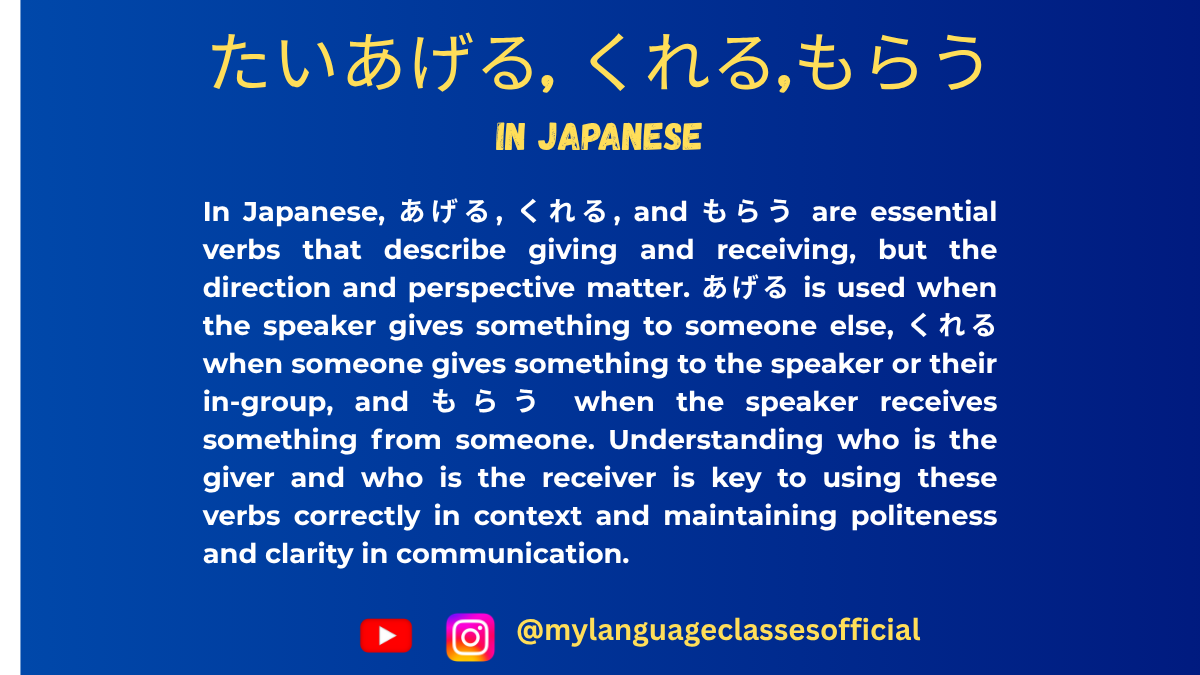Your cart is currently empty!
Tag: Japanese verbs of giving and receiving
-

Mastering あげる, くれる, もらう in Japanese | My Language Classes
Mastering あげる, くれる, and もらう in Japanese
In Japanese, verbs of giving and receiving are key to navigating interpersonal relationships and expressing social dynamics. These verbs—あげる (ageru), くれる (kureru), and もらう (morau)—carry not only their literal meanings but also nuances reflecting social positioning and perspective. Understanding these verbs will elevate your Japanese communication skills and cultural comprehension. Let’s break them down with examples to guide your learning.
あげる (ageru): To Give (When You or Someone Gives to Others)
あげる emphasizes that the giver (the subject of the sentence) is offering something to someone else. It is often used when the recipient is considered equal to or higher in social status.
Example 1: Giving a Book to Your Mother
母に本をあげる
(Haha ni hon o ageru)
“I give a book to my mother.”Here, the giver (you) is offering the book to your mother. The に particle marks the recipient of the action, in this case, “mother” (母).
Example 2: Giving Chocolates to a Friend
友達にチョコレートをあげる
(Tomodachi ni chokorēto o ageru)
“I give chocolates to my friend.”あげる frames the action from the perspective of the giver, showing that the chocolates move from you to your friend.
くれる (kureru): To Give (When Someone Gives to You or Your Group)
くれる is used when someone gives something to you, your family, or your inner circle. It reflects the act of giving from the recipient’s (your) perspective.
Example 1: Receiving a Present from a Friend
友達がプレゼントをくれる
(Tomodachi ga purezento o kureru)
“My friend gives me a present.”Here, the subject is “friend” (友達), who is giving the present (プレゼント) to you. Notice how くれる focuses on the speaker’s perspective, framing the act of giving as it relates to you.
Example 2: Your Sister Gives You a Pen
妹がペンをくれる
(Imōto ga pen o kureru)
“My younger sister gives me a pen.”The action is centered on what you (the speaker) receive, with the subject being the giver (your sister).
もらう (morau): To Receive
もらう flips the perspective entirely, focusing on the receiver of the action. The giver is marked with the particle から or sometimes に, while the thing received is the direct object.
Example 1: Receiving a Book
本をもらう
(Hon o morau)
“I receive a book.”Here, the act of receiving is the focal point. The giver is understood or can be specified for clarity:
先生から本をもらう
(Sensei kara hon o morau)
“I receive a book from my teacher.”Example 2: Receiving a Gift from a Friend
友達からプレゼントをもらう
(Tomodachi kara purezento o morau)
“I receive a present from my friend.”から specifies the giver, highlighting the source of the action.
Key Differences and Social Nuances
- Perspective Matters:
- Use あげる when the speaker gives to someone else.
- Use くれる when someone gives to the speaker or their group.
- Use もらう when the speaker receives something.
- Hierarchy and Politeness:
These verbs subtly reflect social hierarchies. For example, when giving to someone of higher status, you may pair あげる with a more polite verb like 差し上げる (sashiageru). Similarly, くださる is a respectful form of くれる. - Indirect Speech and Cultural Sensitivity:
In Japanese culture, indirectness is often preferred. Instead of stating directly “I gave a gift,” one might say, プレゼントをあげました (Purezento o agemashita), emphasizing the act without being overly direct.
Practice with Full Sentences
Try these examples to reinforce your understanding:
- 私は友達にお菓子をあげた。
(Watashi wa tomodachi ni okashi o ageta.)
“I gave sweets to my friend.” - 母が私に時計をくれた。
(Haha ga watashi ni tokei o kureta.)
“My mother gave me a watch.” - 先生に鉛筆をもらいました。
(Sensei ni enpitsu o moraimashita.)
“I received a pencil from my teacher.”
Final Tips for Mastery
- Listen and Observe: Pay attention to how native speakers use these verbs in conversation or media. Notice the particles and nuances.
- Role-play Situations: Practice using these verbs in various contexts, like giving gifts, thanking someone, or describing exchanges.
- Expand Vocabulary: Learn related words like 差し上げる (to humbly give), くださる (to respectfully give), and いただく (to humbly receive).
By mastering あげる, くれる, and もらう, you’ll not only enhance your Japanese skills but also gain a deeper appreciation for the culture and its emphasis on relationships and social awareness.
If you enjoyed this lesson, be sure to check out more posts like this on my blog at My Language Classes. Don’t forget to subscribe my YouTube channel and follow me on Instagram for the latest language learning tips and lessons. Leave a comment below to share your thoughts, or ask any questions you have about nouns.
Happy learning! 😊
- Perspective Matters:
